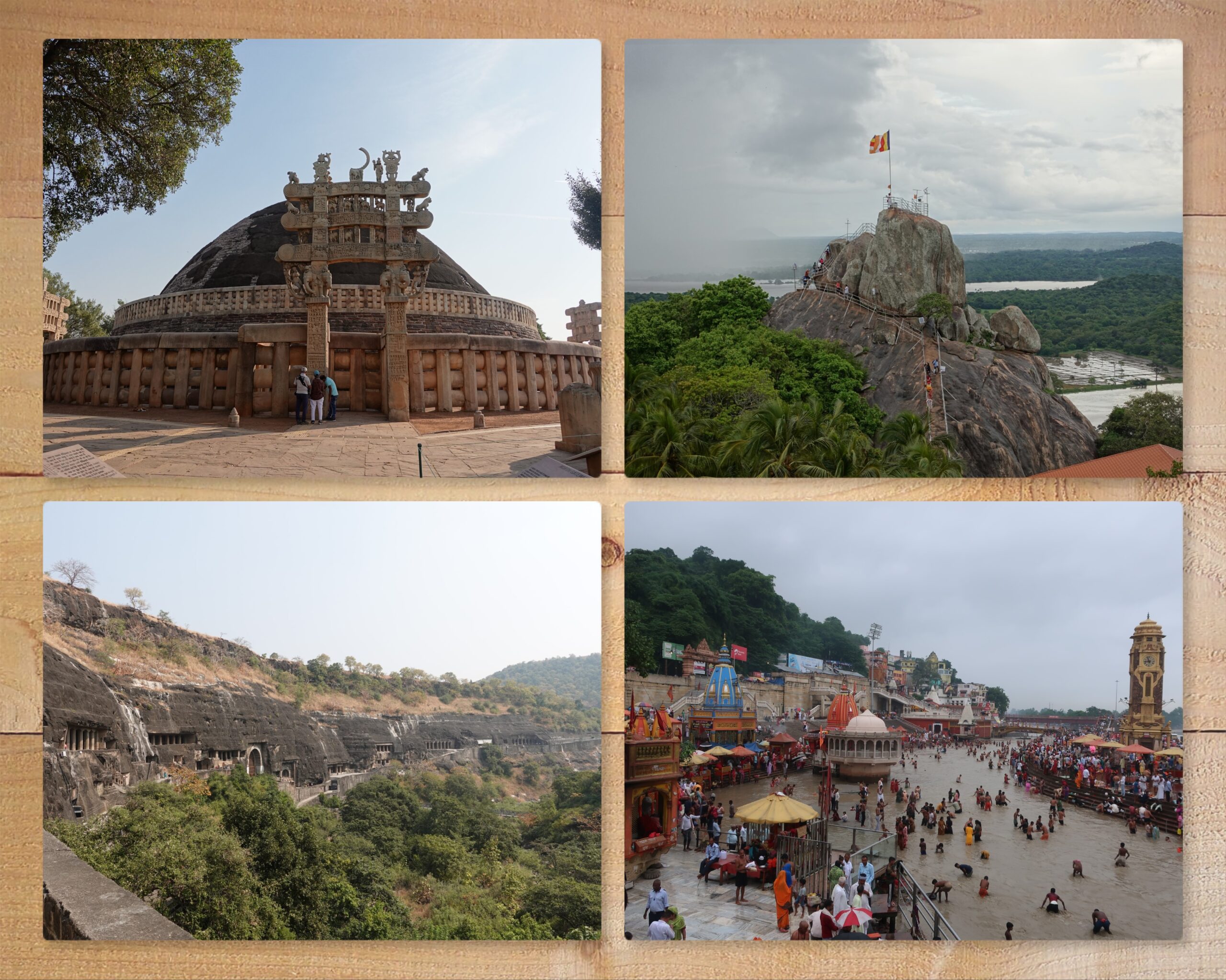Table of Contents
- 1 The Life of Buddha (Shakyamuni Buddha) as Seen from Local Photographs (25) A Very Brief History of Buddhism after Buddha's Death: The History and Propagation of the Buddhist Faith. Also a few words on the introduction of Buddhism to Japan.
- 1.1 Sutra gathering after Buddha's demise
- 1.2 The Second Sutra Gathering that occurred about 100 years after the Buddha's demise - to the split of the Buddha's cult.
- 1.3 Appearance of King Ashoka
- 1.4 Introduction of Buddhism to Sri Lanka
- 1.5 Buddhist art flourished, including stupas in Saanchi
- 1.6 Around the end of the 1st century A.D. to the 2nd century A.D., the appearance of the Buddha image.
- 1.7 Birth of Mahayana Buddhism
- 1.8 Introduction of Buddhism to China
- 1.9 The heyday of Indian Buddhist art, including Ajanta, Ellora, and Sarnath
- 1.10 The Gupta dynasty of King Chandragupta was established in India - Buddhism was outnumbered by the emergence of Hindu dynasty
- 1.11 The rise of Chinese Buddhism
- 1.12 Introduction of Buddhism to Japan
- 1.13 Genjo Sanzo's Journey to India in Search of the Law
- 1.14 The prevalence of esoteric Buddhism in India and its spread to China. And the entry of Saicho and Kukai into Tang Dynasty China.
- 1.15 The Decline and Fall of Indian Buddhism
- 2 Conclusion - In Reply to the Afterword
The Life of Buddha (Shakyamuni Buddha) as Seen in Local Photographs] (25)
A very brief history of Buddhism after Buddha's death - The history and propagation of the Buddhist cult. Also a few words about the introduction of Buddhism to Japan.
Previous Article(24) Buddha's death at Kushinagara - Buddha on his final journey with his follower Ananda, ending his 80-year life.We have looked at Buddha's life in general in a total of 24 articles up to the present.
In this article, I will give a brief summary of the history of Buddhism since the Buddha's death. It would be reckless to attempt to summarize more than 2,000 years of history spanning the globe in a single page, but I will try to do so in a very rough and ready manner.
So let's get started.
Sutra gathering after Buddha's demise
After Buddha's death, the first challenge was how to summarize and pass on Buddha's teachings.
What this means is that in India at that time, it was not customary to write down teachings in writing, and it was normal for all teachings to be passed down orally. Furthermore, the Buddha's preaching was unique, and he used a flexible approach, changing his teachings according to each person's needs and temperament. In other words, he gave different teachings according to the concerns and temperament of each person.
If Buddha had left behind some kind of scripture that systematically summarized his teachings, there would have been no problem, but as I said, such a practice did not exist in India at that time. Of course, Buddha's basic teachings would have already been shared among his disciples, but there was a wide variety of other teachings that were given to each disciple.
Now that the absolute head, Buddha, is gone, there will be no one to consult with in the future to ask, "What should I do about this?" What should I do? Also, there is no one with absolute authority to arbitrate differences in interpretation among disciples. In this situation, a "more systematic formulation of rules and teachings" is needed to prevent such a situation.
This is why the disciples of the Buddha Order gathered together and began to compile their teachings (sutras). Here it isconcentration. The two main figures at this time were Mahakasyapa, the great disciple, and Ananda, who was a follower of the Buddha. In particular, Ananda is said to have had such an excellent memory that he was called the best of the many, memorizing Buddha's teachings word for word. He was the closest to the Buddha and served him for a long time. Thanks to his memorization of the teachings, the rally was successfully completed. The sutra compiled here, or Buddha's teachings, is called the "Agama," or in Chinese translation, the "Agon Sutra.
The Second Sutra Gathering that occurred about 100 years after the Buddha's demise - to the split of the Buddha's cult.
The first rally was successfully completed without much confusion, partly because it was held by disciples who knew the Buddha directly. However, 100 years have passed since the Buddha's death, and there are no longer people who are directly acquainted with the Buddha. Furthermore, the times have changed, and the way of the Buddha's cult has also changed.
The management of the cult, which was a family-run business at the time of its foundation, was completely different from that of the large cults that had already become fully established in ancient India.
Finally, a decisive event was to take place within the Order of Buddha. The catalyst for this event would be the Second Rally.
A major topic of discussion at the time of the rally was the question of whether or not the Order should be allowed to accept money, salt, and other storable foodstuffs as an offering that it receives.
This was a serious problem in the Buddhist Order. During the Buddha's lifetime, his disciples basically led a life of asceticism without any property of their own, but as time went by, more and more ordained monks settled down in monasteries.
As the Order of Buddha grew, more and more people donated land and buildings. In addition, there were probably requests from believers to "settle down here and stay for us. In response to this, the ordained people also had the advantage of being able to concentrate on their meditation practice by staying at the monastery, and the monastic life spread through reciprocal interactions.
However, when monastic life begins, monks inevitably have to deal with money, food, and other goods for practical purposes. The times were different from the days when people lived in the wild under trees or in caves. The demands of the believers were also different from those of the past.
Conservative groups do not approve of this situation and strongly insist that the rules should remain the same as in the past.
As a result, the Buddhist Order was divided into two groups: the conservative "Theravada" group and the "Popular" group that favored a new way of being. This is called the Fundamental Schism.
From here, the group was further subdivided into smaller groups, each of which preached Buddhism on its own.
Although I said at the beginning of this article that I would give a very brief history of the post-Buddhist period, I have looked at these two rallies quite closely. If I start talking at this rate, you may be wondering when I will finish this article, but don't worry. There is a reason why I have chosen to focus on these two rallies.
First of all, because this rallying event is so important to know that "Buddha's teachings are not the only absolute.
As mentioned earlier, the Buddha used the method of counterpoint. This led to a variety of teachings, sometimes even contradictory ones. The disciples' views were inevitably divided on how to interpret this.
Furthermore, since the Buddha did not systematize his own thought and make it into a scripture, it is difficult to understand the connection between teachings and teachings, and many blanks exist. In other words, there are only a series of one-off teachings, and it is left to the recipient to decide how to interpret them.
It is also important to note that it was not spoken as a holy word from the one and only absolute God, as in monotheistic religions. This leaves room for a wide variety of interpretations.
This is why we can say that sutra is not the only absolute, and that it is inevitably destined to be interpreted in different ways.
You have probably wondered why there are so many Buddhist sutras and sects. This is the background behind it. There are too many gaps in Buddha's teachings. Each sect has its own interpretation of the gaps, and more and more sutras have been created. The Mahayana sutras that came to Japan are largely part of this trend. However, it seems that Buddhism is unique in that no single Buddhist scripture is absolute, and a wide variety of scriptures have been produced by different groups of people. This is why Buddhism has been able to spread so widely across time and regions.
Appearance of King Ashoka
Now, let's proceed quickly from here.
Exactly 100 years after Buddha's death, King Asoka ascended the throne as king of the Maurya dynasty. The date is said to be around 268 B.C. The Maurya dynasty was a great power that ruled all of India at that time. The Maurya Dynasty was a powerful dynasty that ruled all of India at that time. The king was deeply devoted to Buddhism and erected pillars all over India to commemorate the greatness of the Buddha. It is said that it was thanks to him that Buddhism spread throughout India.
And the most famous of these is the Lion Pillar found at Sarnath.
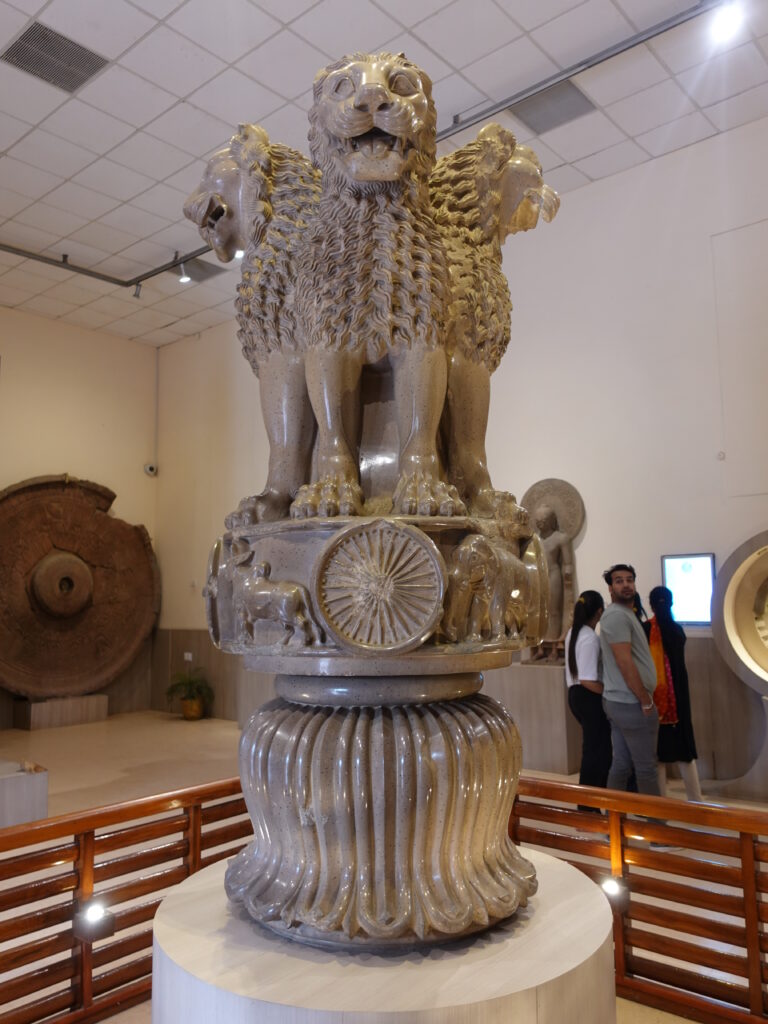
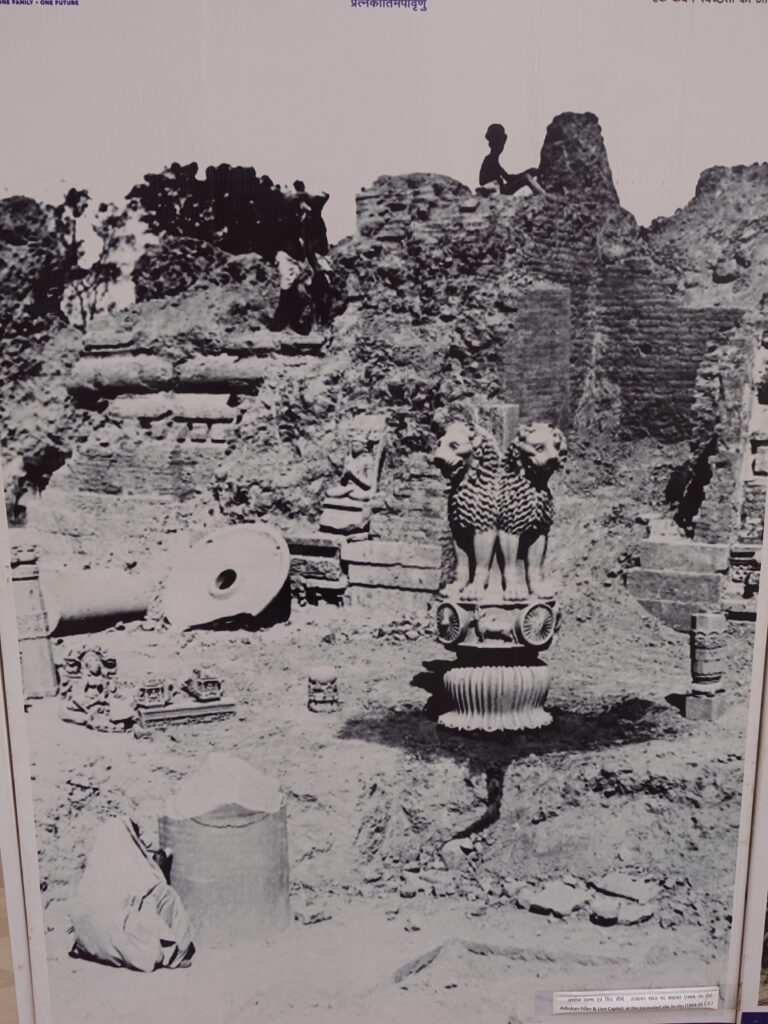
It is known as the highest sculpture in Indian history and has been adopted as the national emblem of India.
I too was overwhelmed by this lion. It is so exquisite! I could understand why this is said to be one of the best sculptures in India.
And King Asoka is historically important in that the existence of these pillars attests to the history of the Buddha. The remains of these pillars had been almost completely buried in the ground since the fall of Buddhism in India in the early 13th century and were subsequently forgotten. However, during the British rule in the 19th century, excavations were conducted and the inscriptions on these pillars proved that they were the remains of Buddha. If it had not been for King Ashoka's pillars, we might never have known the site of the Buddha in India. So we can say that King Ashoka is our great benefactor.
Introduction of Buddhism to Sri Lanka
And this King Asoka's son Mahinda was also amazing! He became an ordained monk and an eminent elder. He then traveled to Sri Lanka where he is said to have introduced Buddhism. This is said to have been around the second half of the 3rd century B.C.
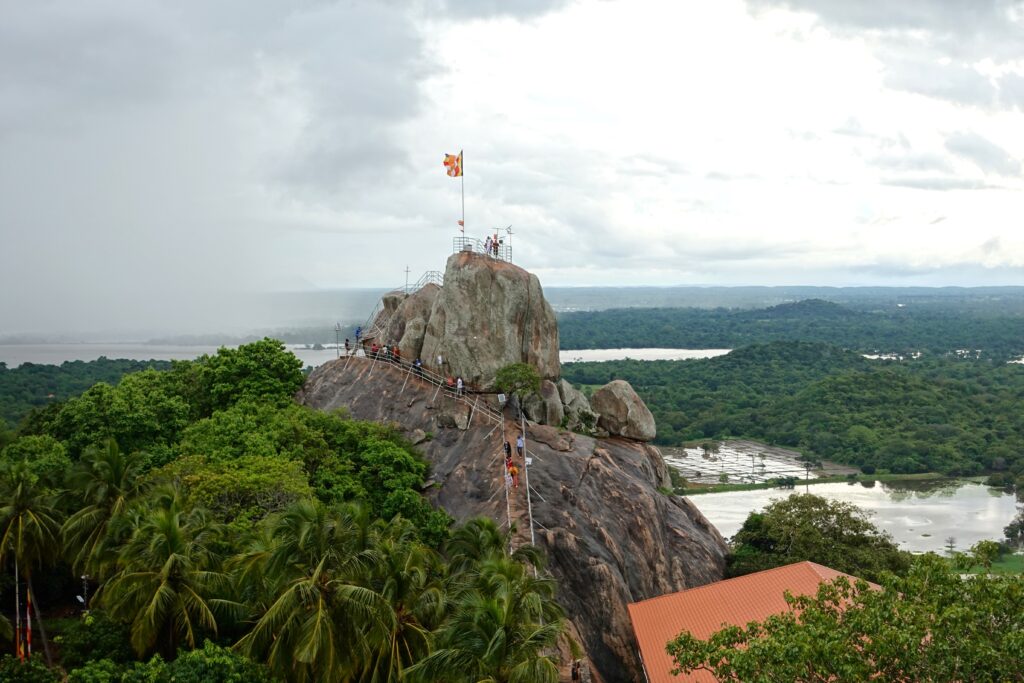
Incidentally, the photo above shows Mihintale, the site of the introduction of Buddhism in Sri Lanka. According to legend, it was on this rock that King Tissa of Sri Lanka and Elder Mahinda met and Buddhism was officially introduced. I visited this place myself and found the mountain to be as austere as the legend says. It was one of the most impressive places in Sri Lanka.
Buddhist art flourished, including stupas in Saanchi
Buddhist art did not develop well for a while after the fall of the Buddha, but from around the second century B.C., stupas with large-scale works of art began to be built. The most representative of these stupas is the Great Stupa at Saanchi.
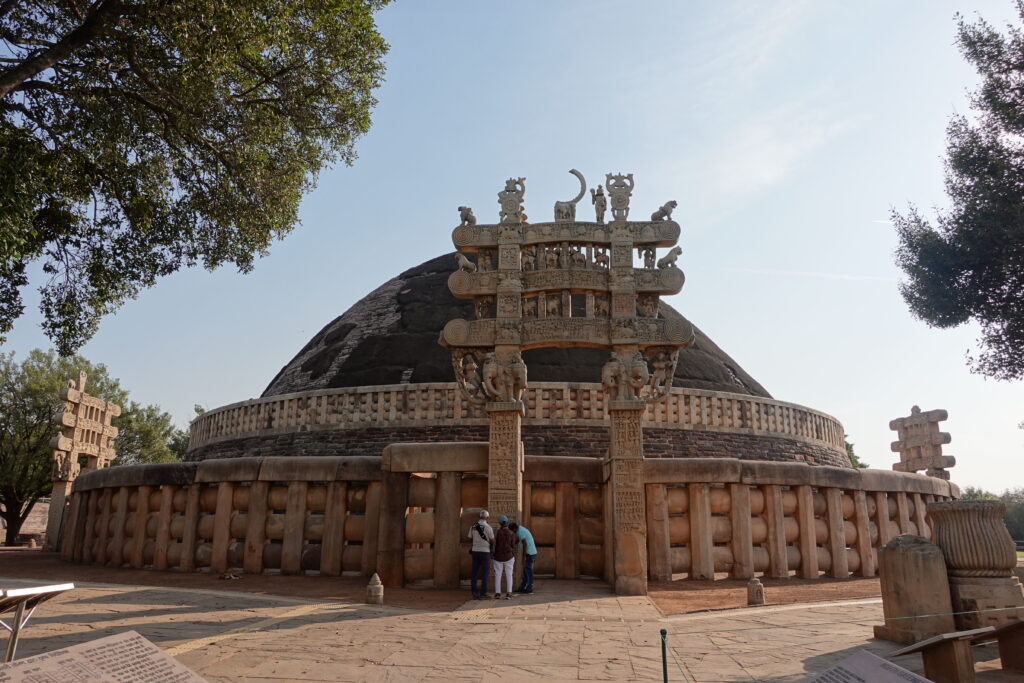
If you compare them to people, you can see their enormity. Not everything was made in the second century B.C., but it is important to note that artistic works of art, and of a fairly high standard, began to be expressed.
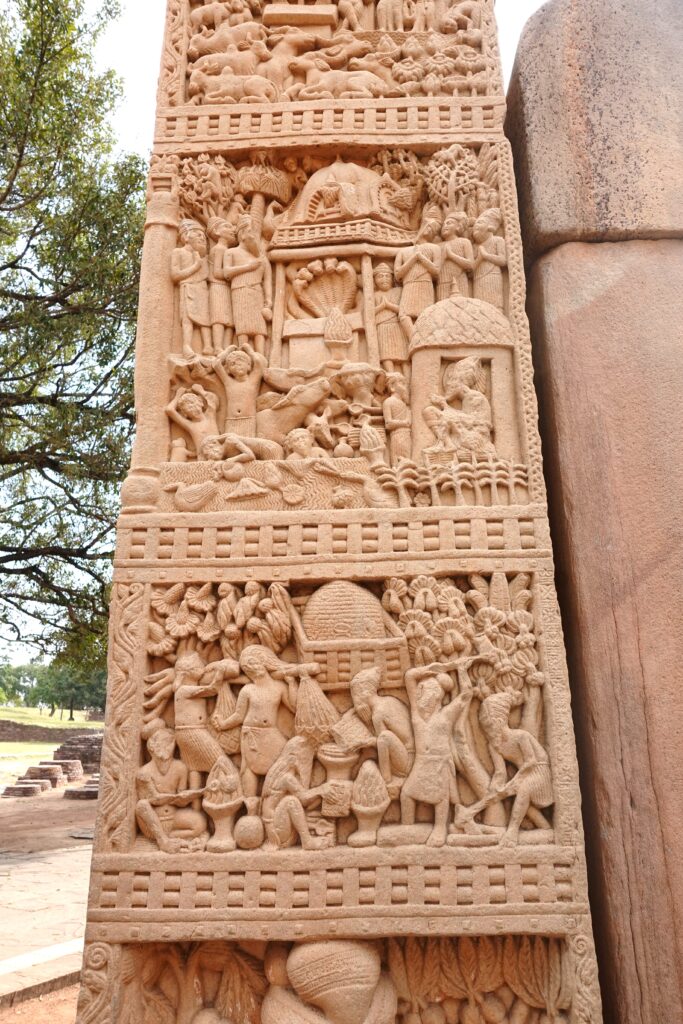
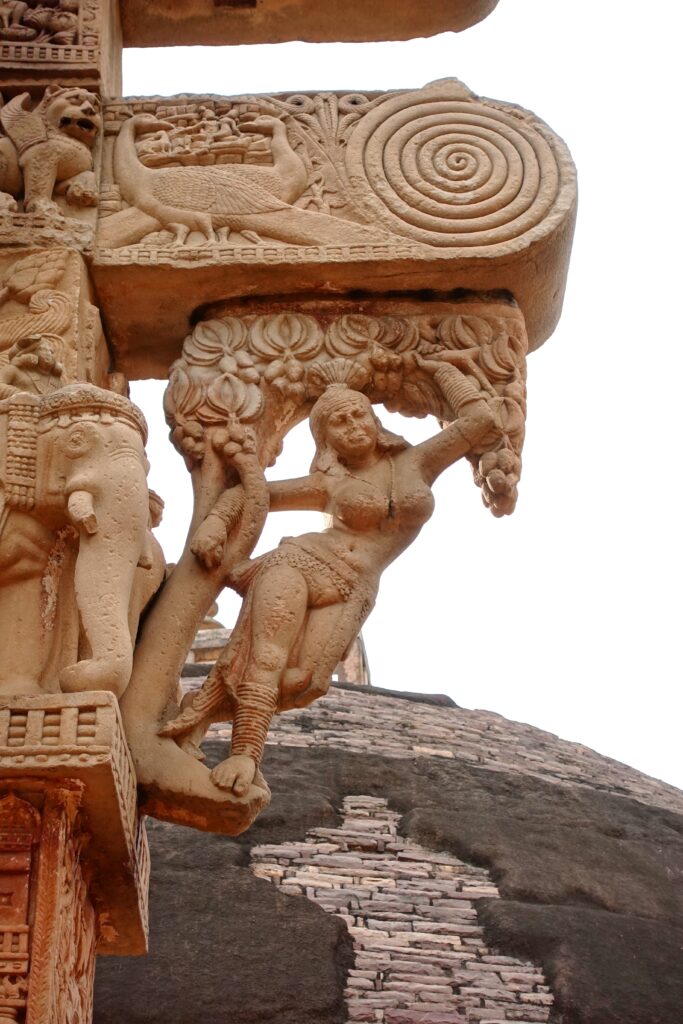
Also, at this time Buddha's image was not yet represented in art. As a sacred being, Buddha was awe-inspiring, so it was common to represent him using various symbols, such as the Bodhi tree.
Around the end of the 1st century A.D. to the 2nd century A.D., the appearance of the Buddha image.
It has been almost more than 400 years since the Buddha passed away, and it is here that the Buddha image finally appears.
Although Gandhara is often mentioned as the beginning of the Buddha image, there is actually another candidate location. That is Mathura, which is close to Agra where the Taj Mahal is located.
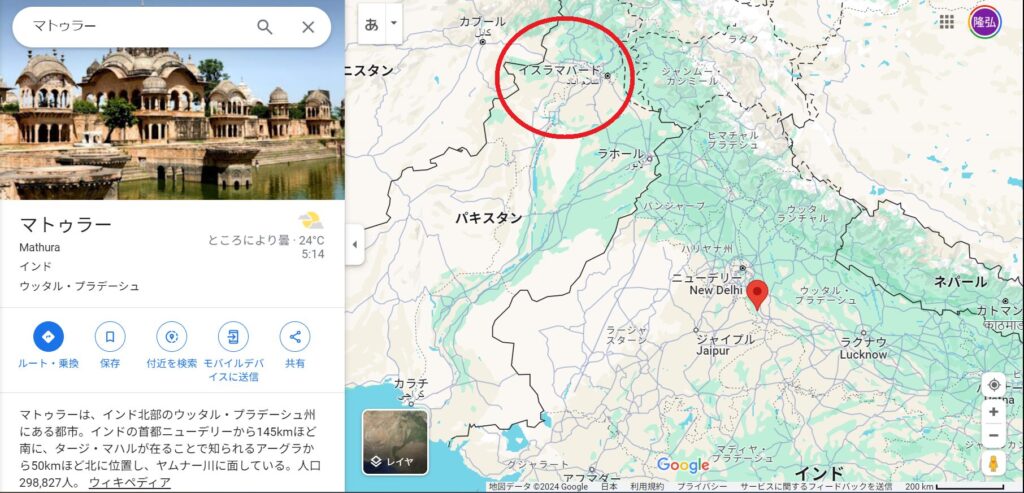
Incidentally, the area circled in red is Gandhara, albeit quite roughly.
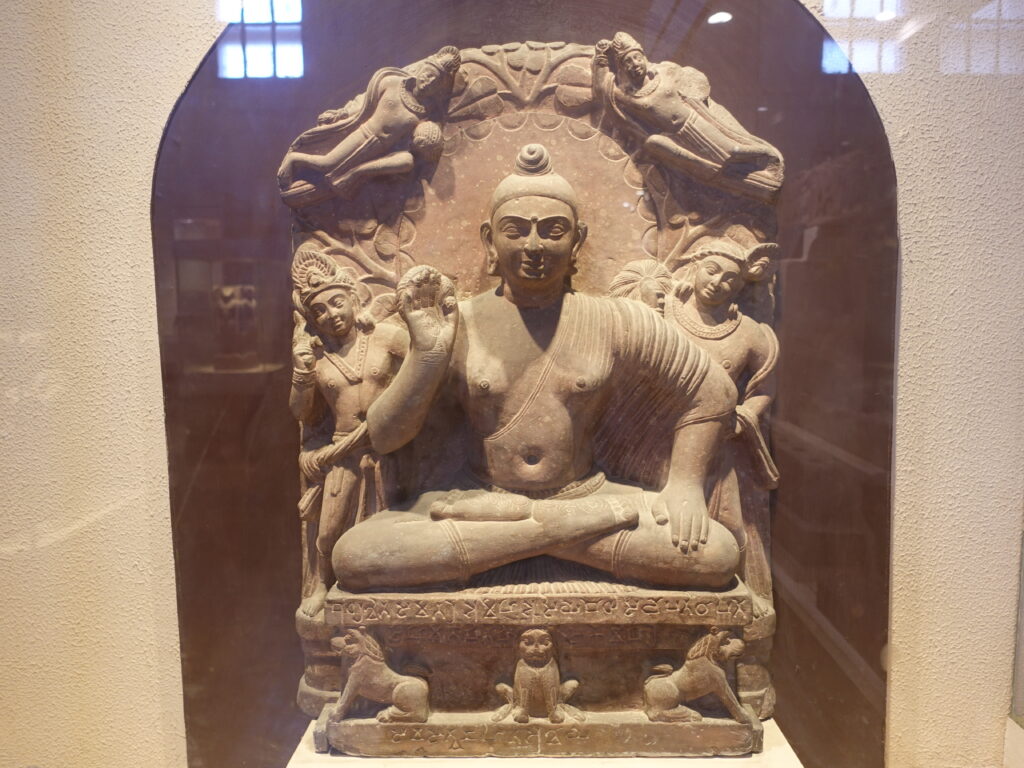
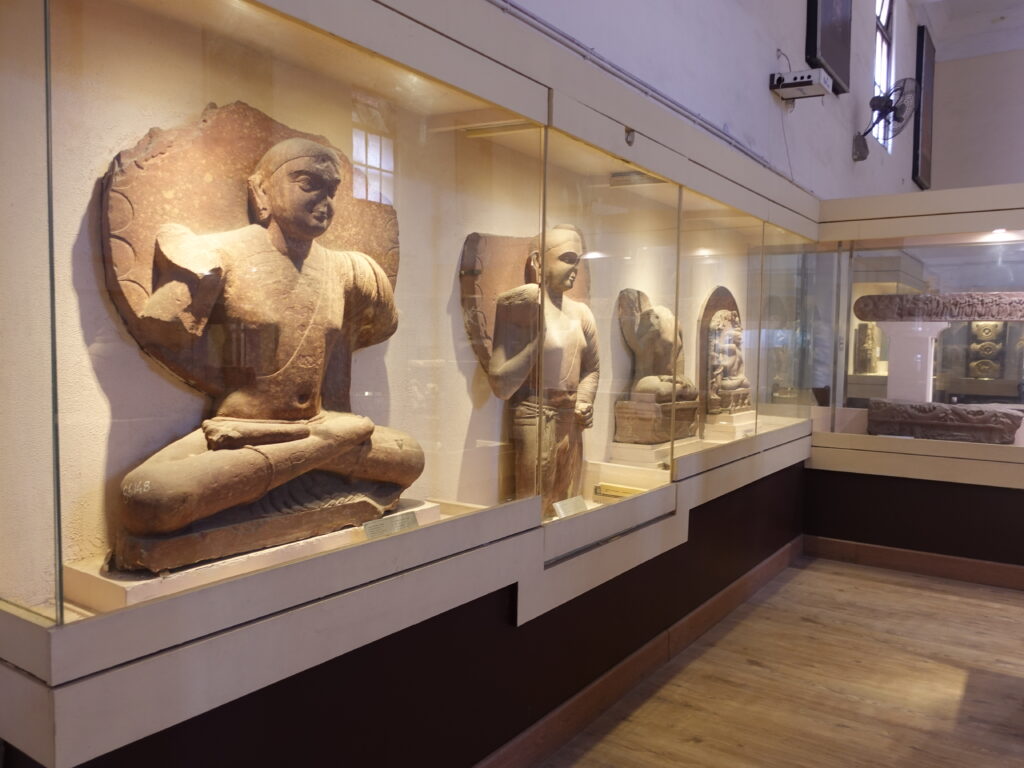
Here is a Buddha image of Mathura made from around the end of the 1st century to the 2nd century.
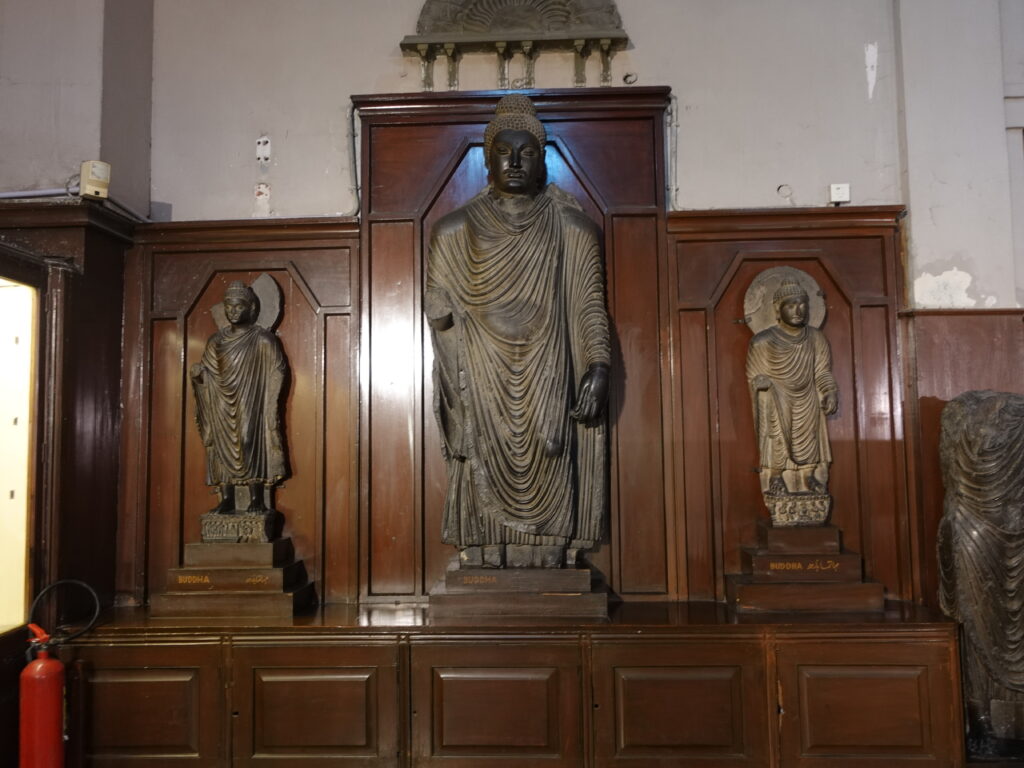
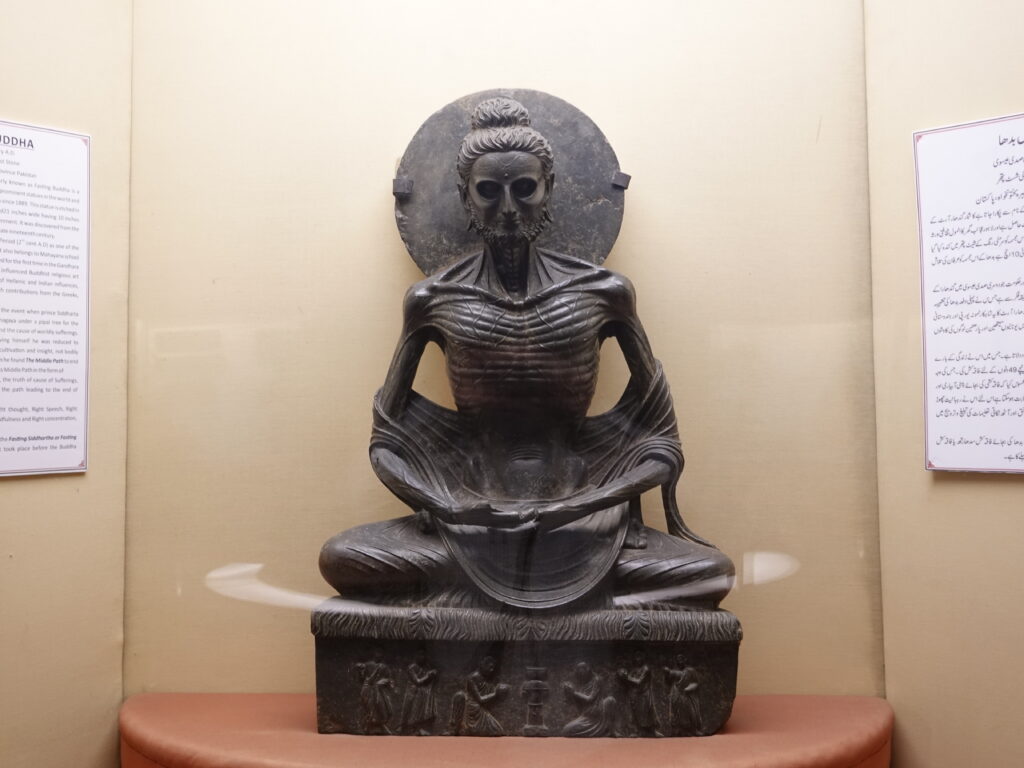
And this is the Gandhara Buddha. While Mathura is more Indian and fleshy, Gandhara is more realistic and sharp. The races are also clearly different from each other.
However, which of the two was first has not yet been settled in the academic world. However, although we do not know which came first, we can say that it was a very epoch-making event in that it broke the taboo against making art of the Buddha's image. From this point forward, the production of Buddha images became more popular than stupas, and belief in Buddha images was born.
Birth of Mahayana Buddhism
Around the first century A.D., the same time that Buddhist statues began to be made, a major movement also began to take place within the Buddhist Order. This was the birth of the Mahayana sutras.
The name "Mahayana Buddhism" itself is familiar to many of you. The Buddhism that we Japanese believe in is basically this Mahayana Buddhism. However, if I were to start talking about what Mahayana Buddhism is, a thick book could be written in no time at all, so I will leave that aside for now.
What is important to note is that the Mahayana Buddhist sutras we believe in, such as the Prajnaparamita Sutra, the Lotus Sutra, and the Amitabha Sutra, gradually began to emerge around the 1st century AD. This is where the flow of Japanese Buddhism began.
Introduction of Buddhism to China
There are various theories about the introduction of Buddhism to China, and it is not known exactly, but it is believed that it first took place in the late 1st century A.D. The introduction of Buddhism began in earnest in the 2nd centuryAnseikouandShirukasenThe first time that the Chinese government began to accept the Chinese language as a foreign language was when the first translating Buddhist monks began to visit China.
However, Buddhism was not actively practiced in China from the beginning, as Confucianism and Taoism were already in existence.
Buddhism still needed more time to flourish.
The heyday of Indian Buddhist art, including Ajanta, Ellora, and Sarnath
I talked about the beginnings of Buddhist statues above, but through the ages other wonderful worlds of Buddhist art opened up.
The most famous of these will be Ajanta, Ellora and Sarnath.
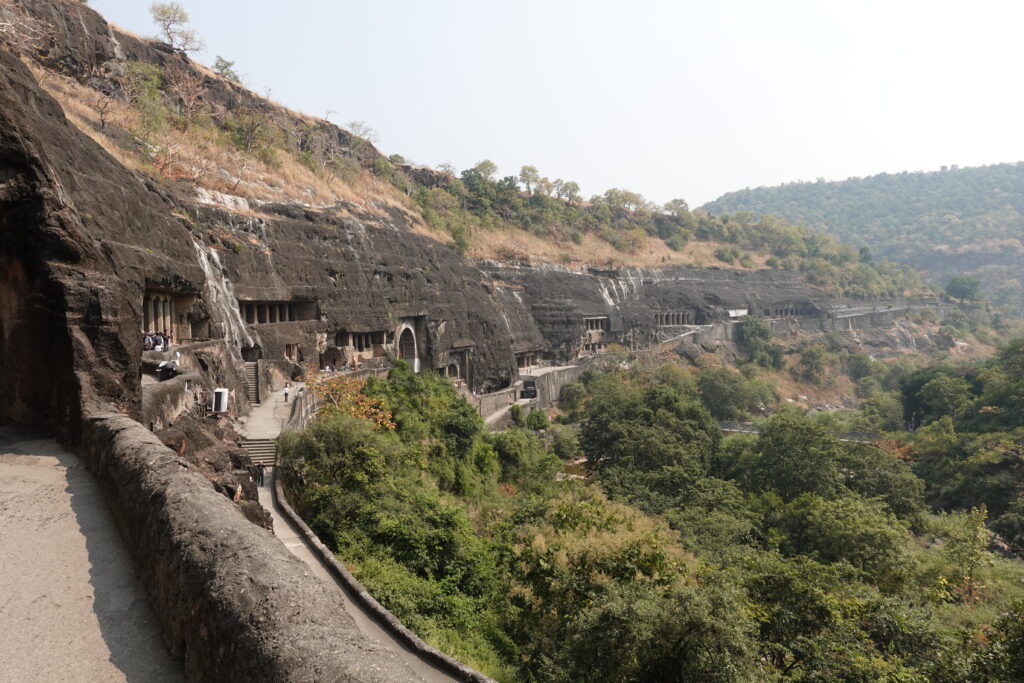
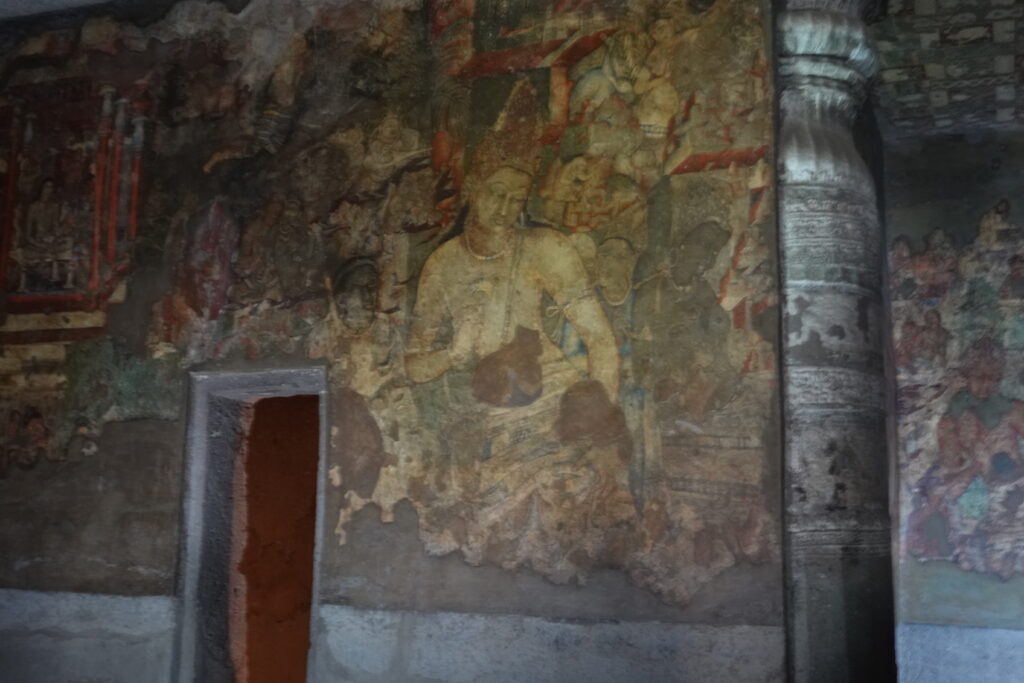
This is the Ajanta site near Mumbai, famous for its murals.
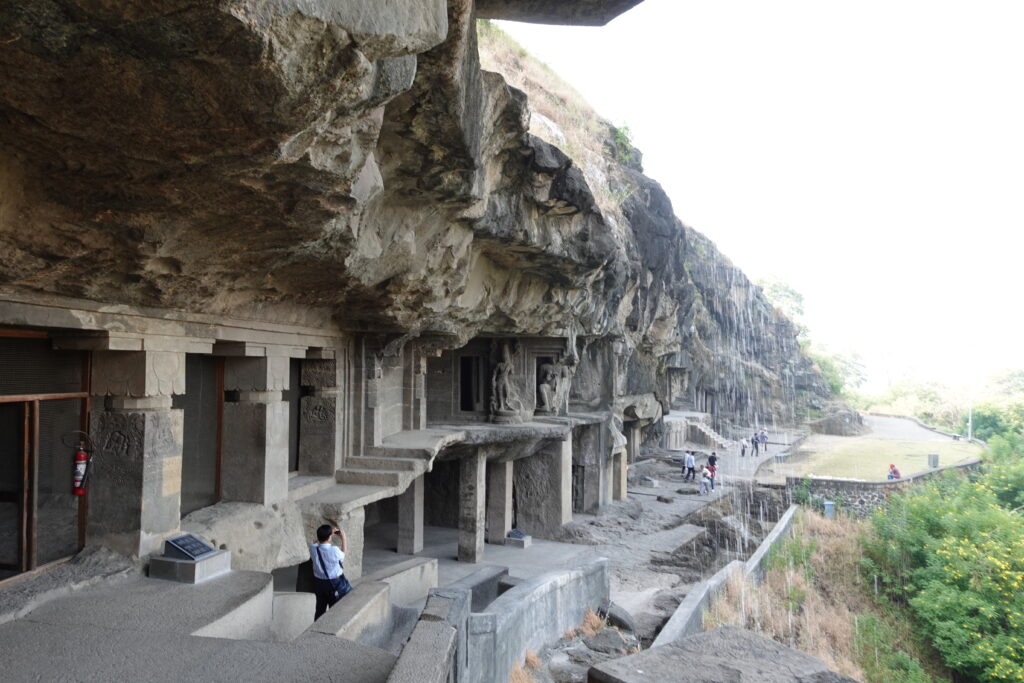
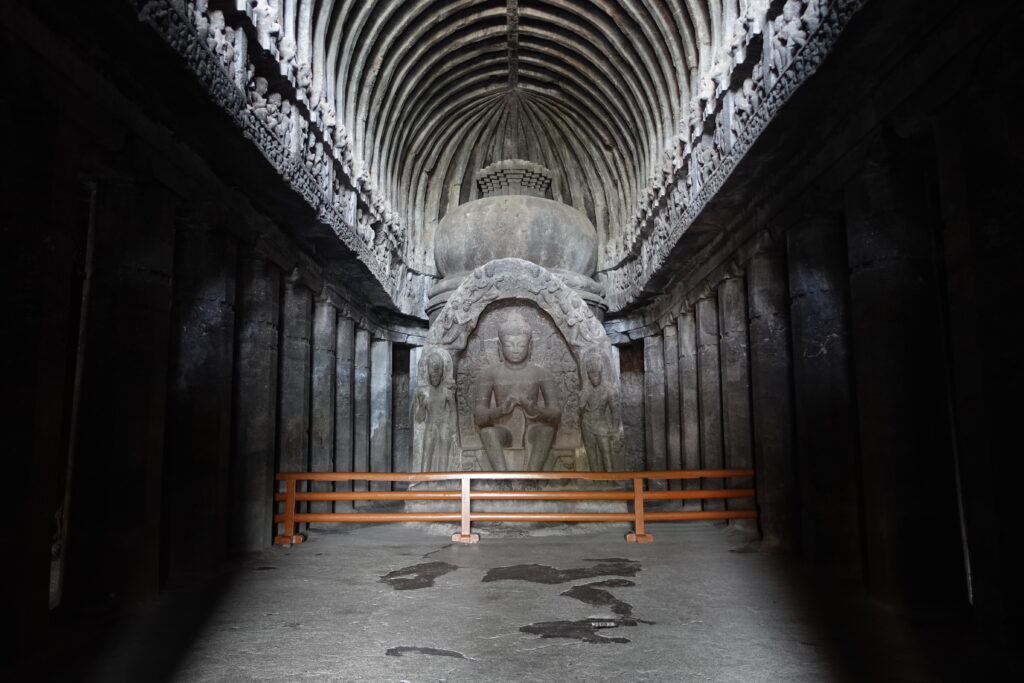
This is also the Ellora ruins near Mumbai. This one is famous for the Buddha image hollowed out of a rock, and is personally one of the best spots for Indian Buddhist sites. I was so shocked that an electric current flowed through my body. I would like to introduce these Ajanta and Ellora ruins in detail in another article.
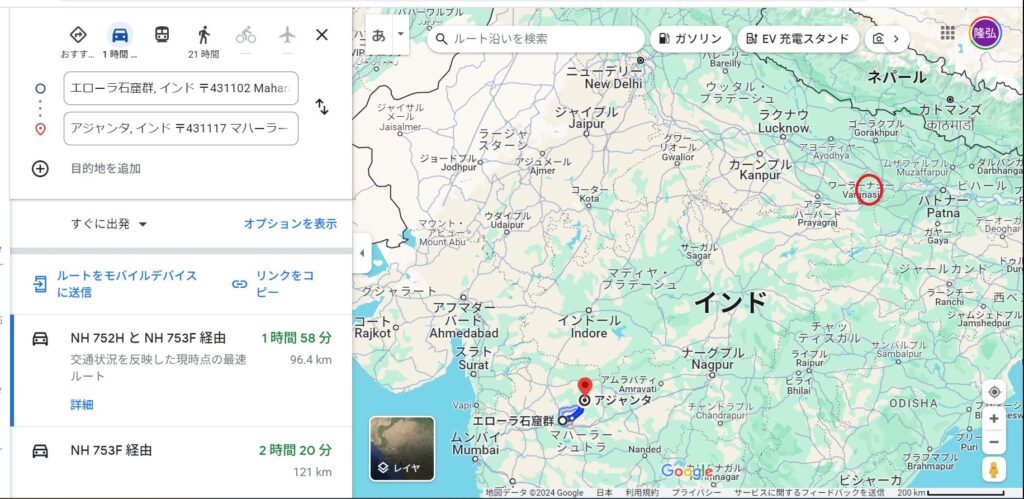
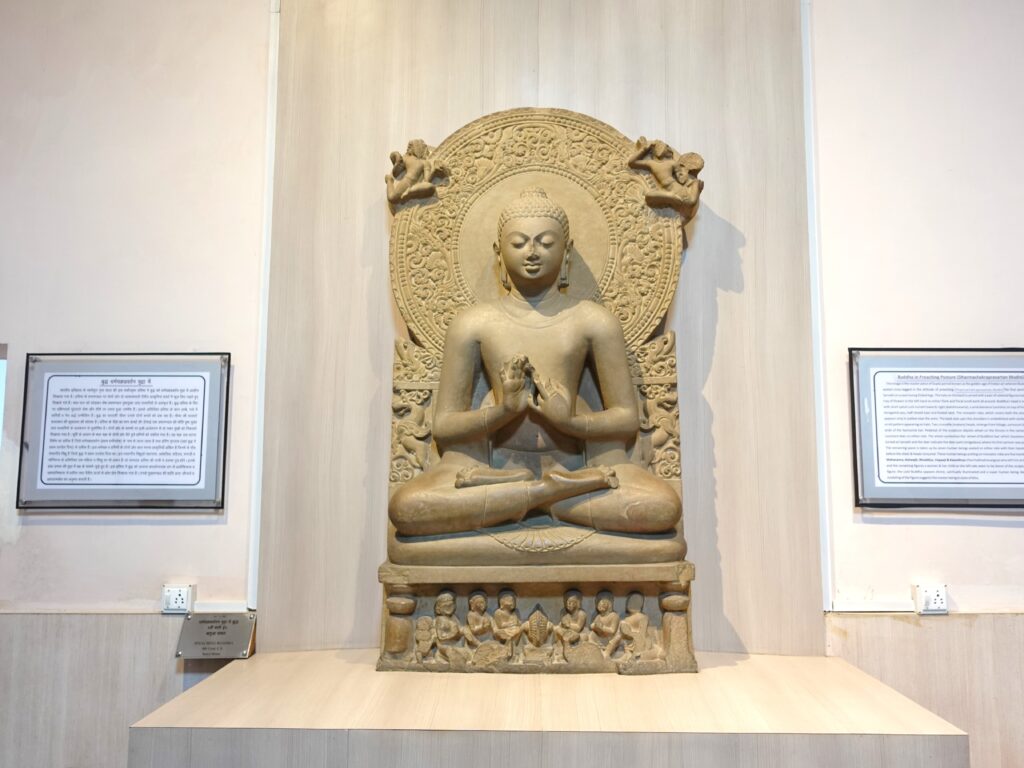
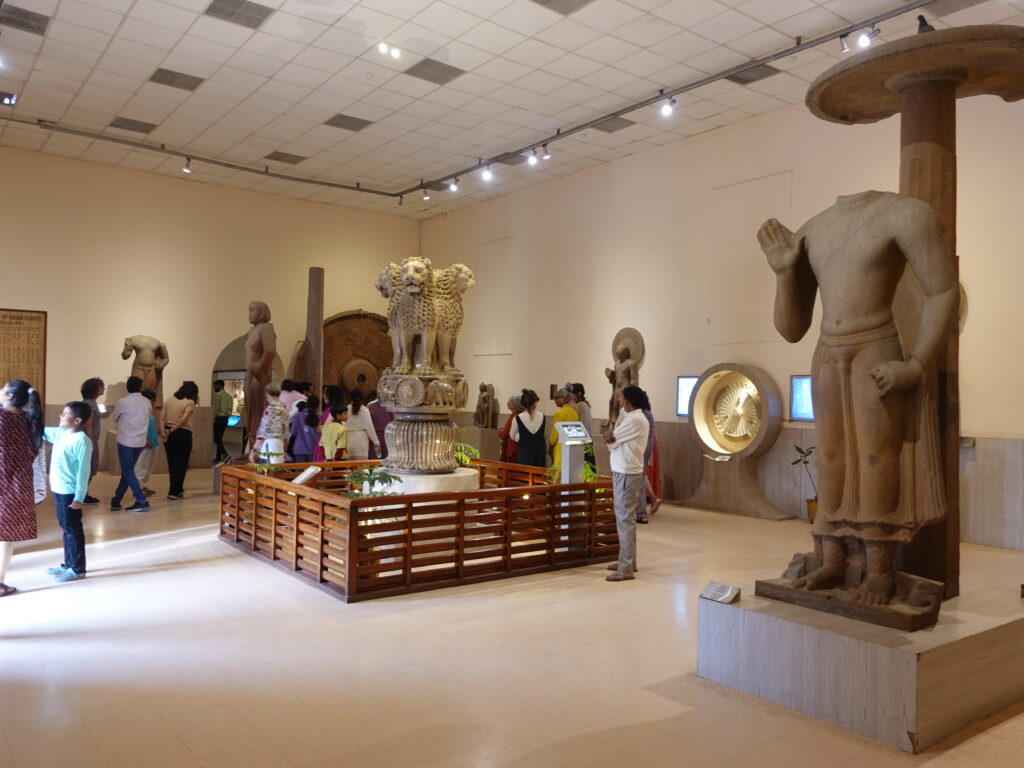
And the third is Sarnath, which is located on the outskirts of Varanasi (Waranasi on the map), famous for the Ganges River. This is the area circled in red on the map above.
It is a sacred site famous for Buddha's first wheel turning, and is also known as a mecca for the production of Buddhist statues along with Mathura and Gandhara. Among them, the Sarnath Buddha, made around the 5th century, is famous as the masterpiece of Indian Buddhist statues.
The Gupta dynasty of King Chandragupta was established in India - Buddhism was outnumbered by the emergence of Hindu dynasty
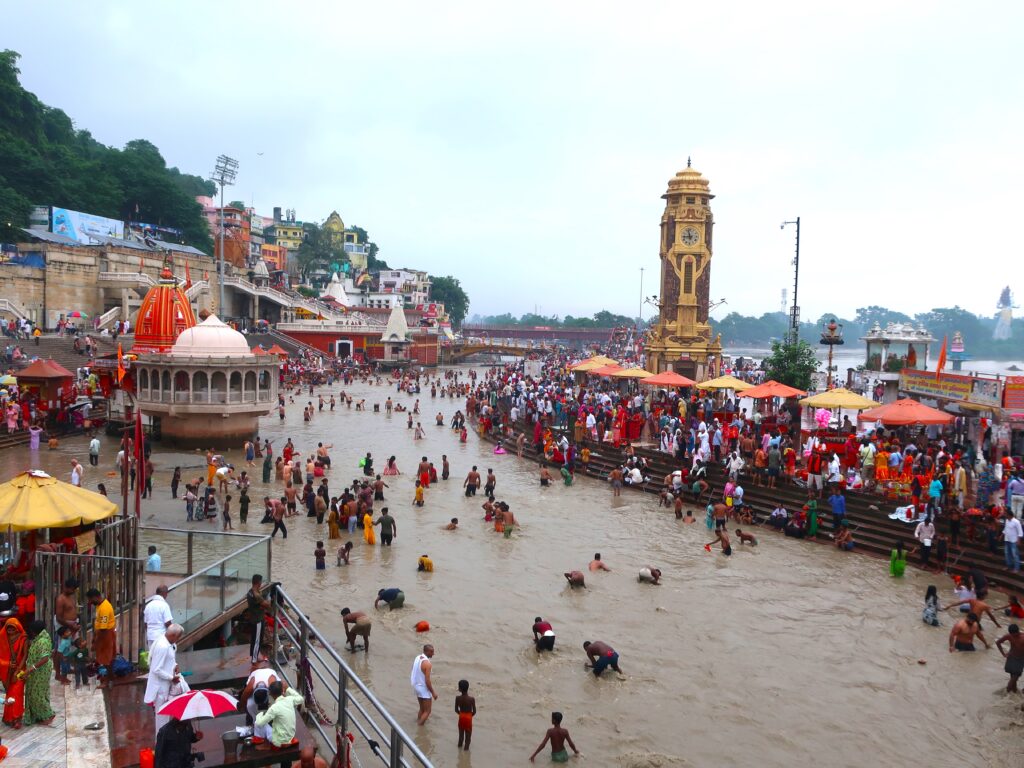
Around 320 AD, the Gupta dynasty was established in India. Hinduism gained momentum during this period because of its emphasis on Hinduism. Hinduism had already begun to establish its doctrines in the 4th century B.C., interacting with Buddhism and Jainism, but it was here that it exploded in popularity in India.
To make matters worse for the Buddhist Order, the Roman Empire was in decline, trade was slowing down, and the major merchants who had been its main sponsors were falling one after another. Thus, the Buddhist Order lost its main support and gradually began to lose its centripetal force.
The rise of Chinese Buddhism
In the 4th and 5th centuries, a large number of sutras were brought from India to China, and Chinese translations of the sutras were rapidly promoted. In the 6th century, a new development that had not occurred in India was born.
This was the birth of a Buddhist sect based on the Mahayana scriptures. In fact, there is little evidence that Mahayana Buddhism became mainstream in India. (*For more information on this area, see Gregory Schopen.Monastic Life in India During the Rise of Mahayana Buddhism.(see also)
The Mahayana sect of Buddhism was never established in India, the birthplace of Buddhism. It flourished in faraway China.
From this point on, the Tendai and Hosso sects, which were based on Mahayana Buddhist scriptures, and the Pure Land faith began to flourish in China.
Introduction of Buddhism to Japan
There are two theories about the arrival of Buddhism in Japan, one in 538 and the other in 552, but in either case, it came from China via Korea. As mentioned above, this was a time when Buddhism was gaining momentum in China. The fact that Buddhism was introduced to Japan and accepted in Japan in such an era may indicate that Japan was already sensitive to the political situation of the international community in East Asia at that time.
Genjo Sanzo's Journey to India in Search of the Law
And we must not forget Genjo Sanzo.

He is so famous in Japan that the name "Sanzou Priest = Genzyou." What made him world famous was that he traveled all the way from China to India in search of the Sanzou (a group of sutras: Sutra, Ritual, and Theory) and successfully brought and translated a large number of sutras into China.
And such was his journey, of course, that he became the model for "Journey to the West".The Tang Dynasty Chronicles of the Western Regions.It is a surprising fact that the remains of the Buddha were excavated by the British in the 19th century according to the description of Without Genzyou's record, the remains of the Buddha might have remained unexcavated and buried. In this sense, it can be said that the greatness of Genzyou has been immortalized.
The prevalence of esoteric Buddhism in India and its spread to China. And the entry of Saicho and Kukai into Tang Dynasty China.
Esoteric Buddhism also began to flourish in Indian Buddhism around the 7th century. Esoteric Buddhism, as the name suggests, is a secret teaching. To be more specific, esoteric Buddhism is a religion that attempts to attain enlightenment through rituals using fire and incantations. Strictly speaking, there are more detailed definitions, but in very rough terms, esoteric Buddhism is such a mystical Buddhism.
It is important to note, however, that this esoteric Buddhism also did not emerge independently from Buddhism, but rather out of competition with Hinduism.
As mentioned above, Buddhism was beginning to be pushed aside by Hinduism after the advent of the Gupta dynasty. Hinduism had taken over from Brahmanism, which had originally been supported by the general Indian populace, and had also absorbed indigenous beliefs to become a huge religious system. Rituals and ceremonies were also refined and began to capture the hearts and minds of the people.
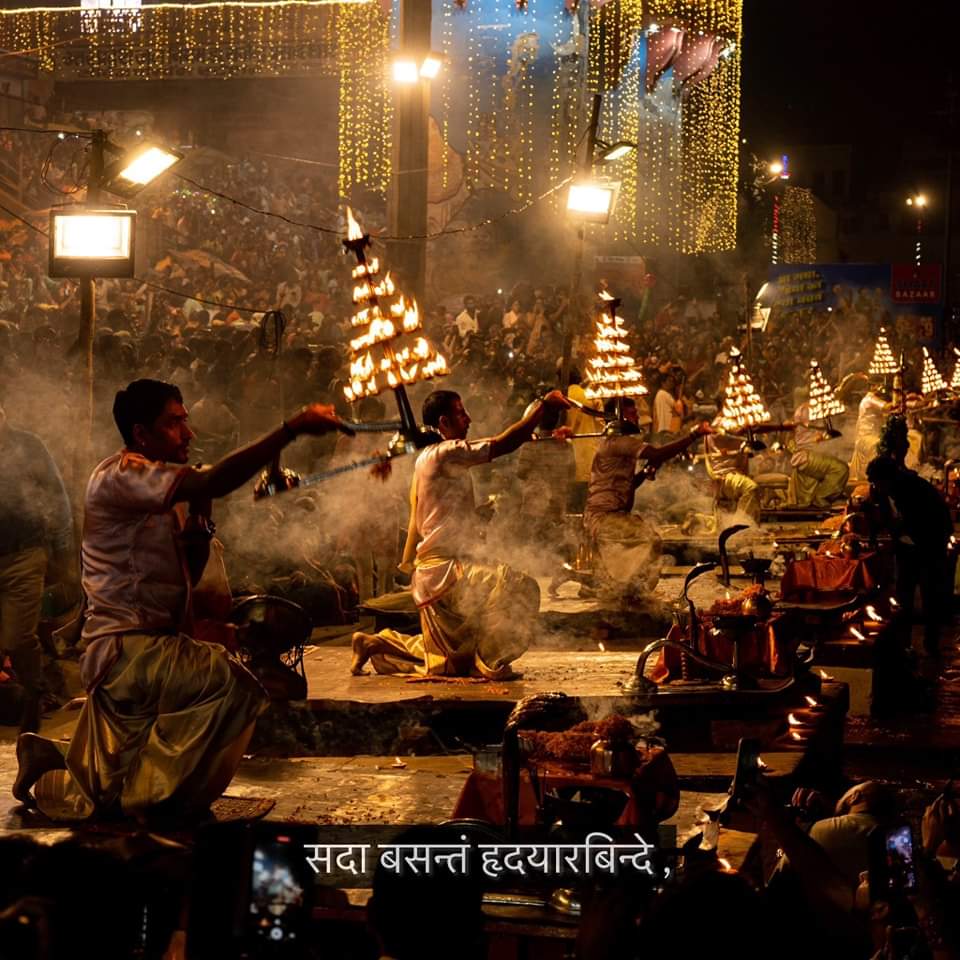
Esoteric Buddhism was born as a result of the incorporation of Hindu rituals to counter these trends. The burning of goma, incantations, and the use of tools are also connected to this.
Esoteric Buddhism grew rapidly in this movement and spread among Buddhists in India, Sri Lanka, and Southeast Asia. Borobudur, one of the world's largest Buddhist monuments on the Indonesian island of Java, was born out of this trend.
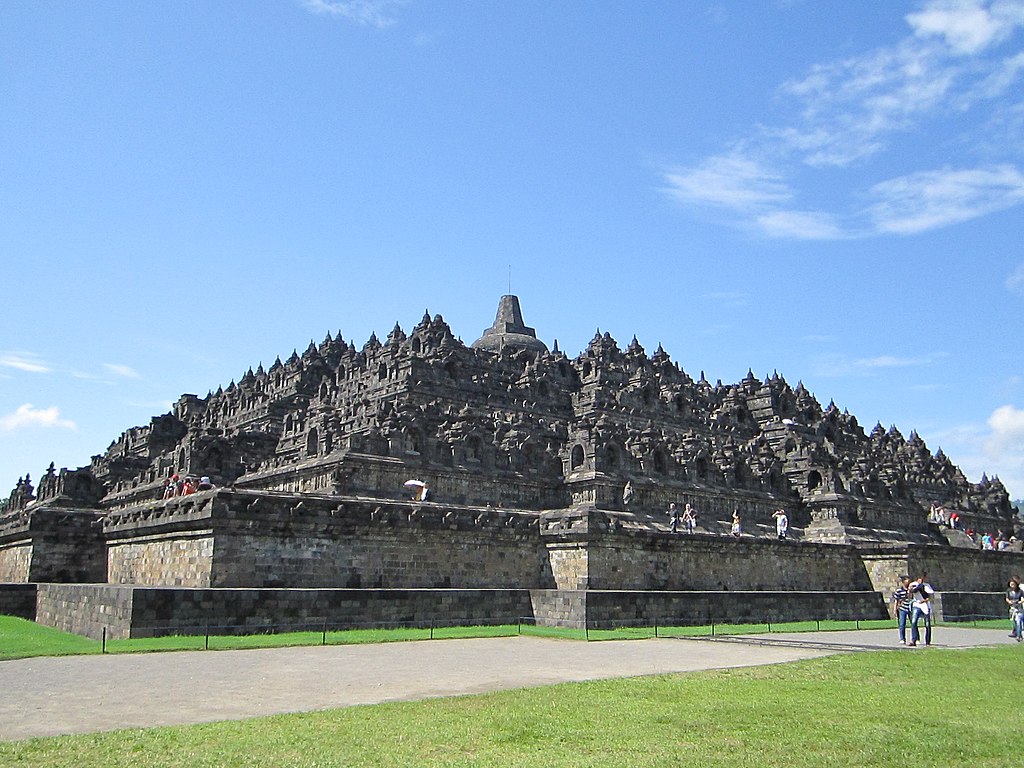
Esoteric Buddhism eventually spread not only to Southeast Asia but also to China, where it became the newest and most popular Buddhist thought. And, unfortunately, it was Saicho and Kukai who came to China at the right time...
As I mentioned earlier in the introduction of Buddhism in Japan, here again Japan has succeeded in immediately adopting the cutting edge of international affairs in the Asian world. Moreover, in the case of esoteric Buddhism, Japan is entering a Buddhist community that encompasses not only the relationship between China and Japan, but also the international affairs of Southeast Asia. It seems that Japan used to have a much better grasp of international information than I had imagined. This surprised me as well.
The Decline and Fall of Indian Buddhism
Now, Indian Buddhism, which adopted Hindu rituals and became esoteric, began to suffer from unexpected side effects.
That was the Hinduization of Buddhism.
As we have seen in previous articles in this series, Buddhism began as a criticism of Brahmanism. In other words, it was originally supposed to be a religion that was different from Hinduism, which is a continuum of Brahmanism. However, through esoteric Buddhism, it has turned into a Hindu religion.
In this way, Buddhism loses its uniqueness and becomes increasingly rarefied.
Furthermore, Hinduism also came to treat Buddha as an incarnation of Vishnu, one of the three great gods of Hinduism.
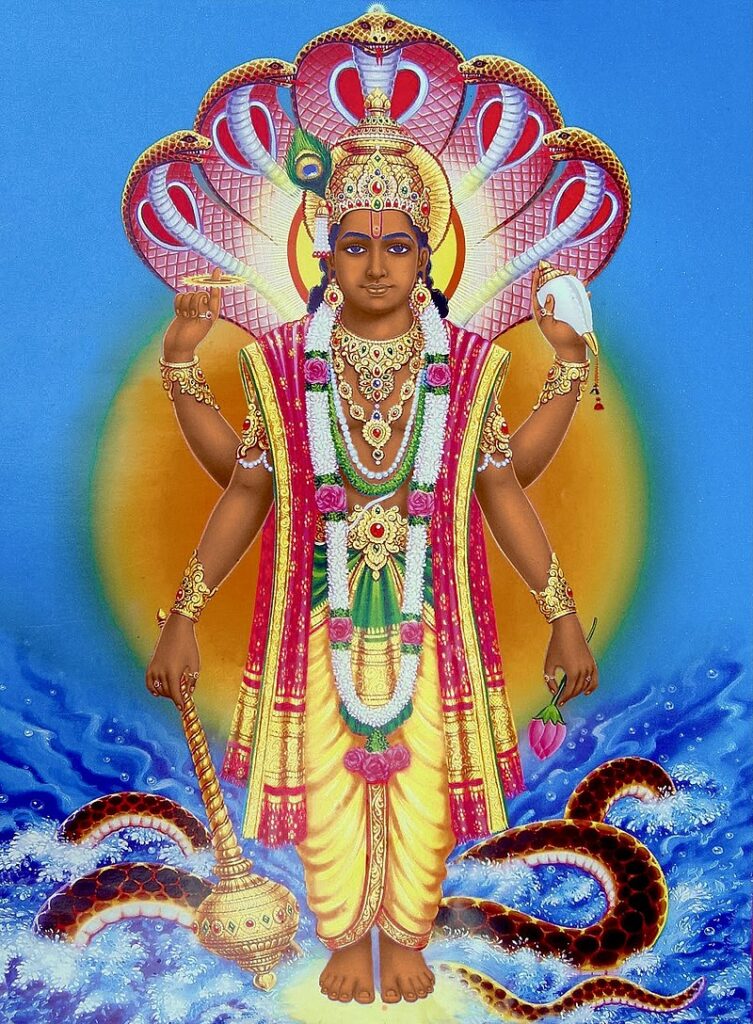
Lord Vishnu was famous for having various incarnations, and Buddha was placed as one of them, and Buddha came to be worshipped as an Indian god within Hinduism. This is how Buddhism was absorbed into Hinduism for Indian people. (On the other hand, Buddhism has incorporated Lord Vishnu as Avalokitesvara, so it is a kind of a composite of the two...)
Thus, the power of Buddhism gradually weakened in India. Although Buddhism once had powerful supporters in the form of royalty, aristocracy, and big merchants, India was now dominated by Hindu dynasties, and the merchants were all devotees of Hinduism. Buddhism had not had much support from the general public in the past, but now that these major sponsors were no longer present, the fate of Buddhism in India was hanging in the balance.
Then comes the last time.
This was the invasion of Islamic powers in the late 12th and early 13th centuries. For their monotheistic culture, Buddhist temples were hateful pagan temples. They smashed Buddhist statues and thoroughly destroyed monasteries, inflicting irreparable damage on the Buddhist cult.
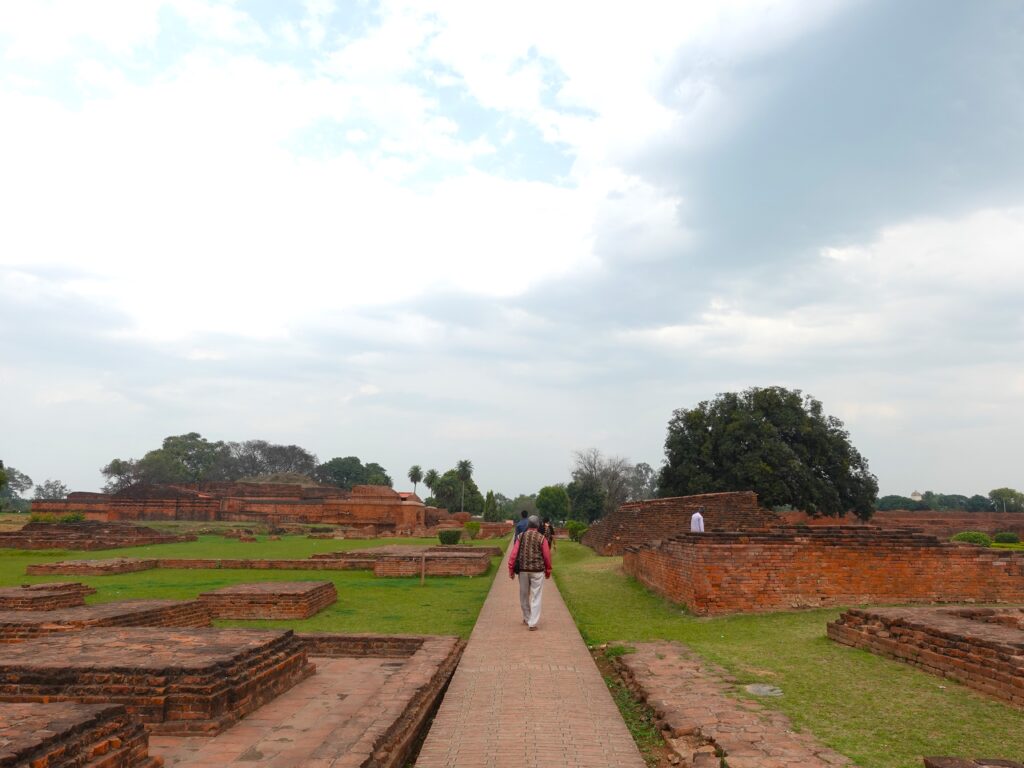
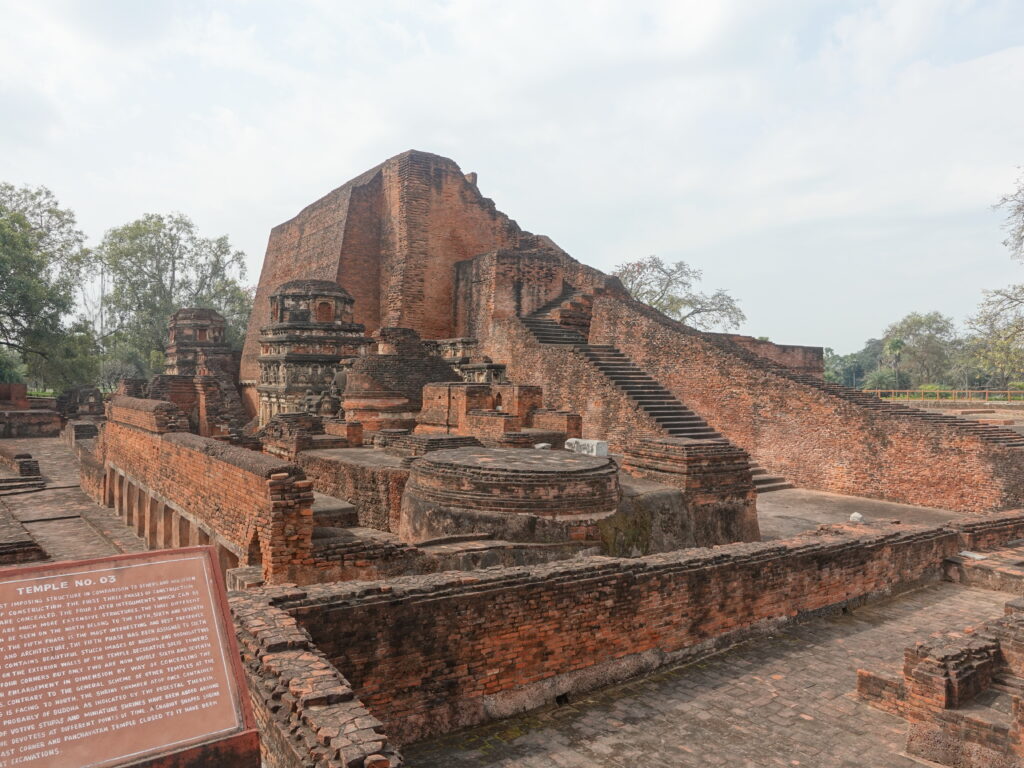
This is the site of Nalanda University, which was the most important monastery in India. This site was also thoroughly destroyed by the Islamic invasion.
Nalanda University is located close to Rajigir, and it is said that Sāriputta and Moggallāna were from villages in this area. It has long been known as a center of learning, and by the 5th century it was functioning as a university at the forefront of Indian scholarship.
It was here that Genzyou Sanzou set out for India. It is said that more than 1,500 professors were stationed here and about 10,000 students were studying day and night, making it a mecca for Buddhist studies. Genzyou risked his life to travel to India to study here.
However, the University of Nalanda, which had been so prosperous, was destroyed by the Islamic invasion at the end of the 12th century, and all its valuable books were burnt to ashes. It is said that the flames burned for six months.
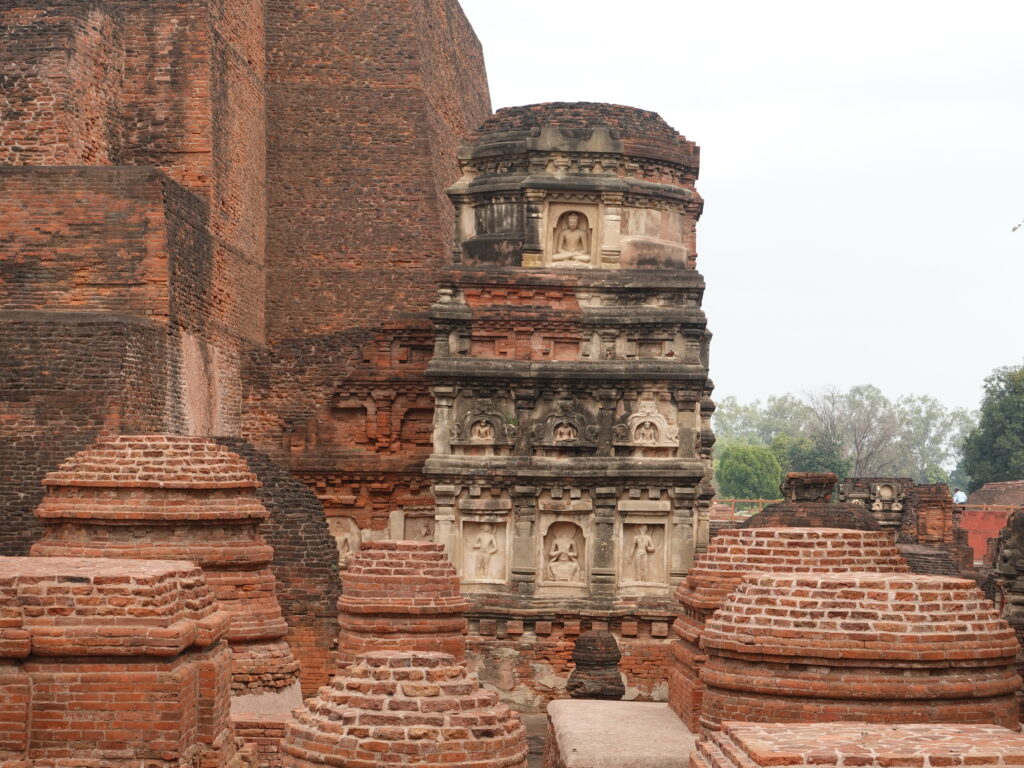
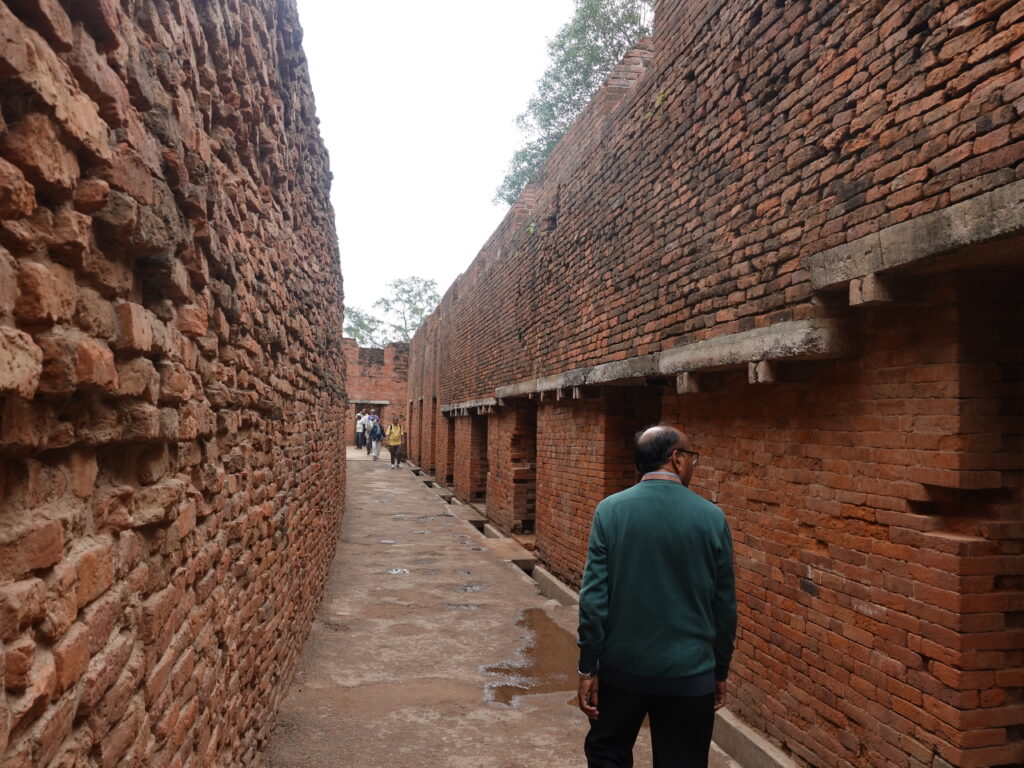
Do you see the headless Buddha image at the bottom of the tower in the photo on the left? Thus, Buddha images in India were destroyed by Islamic forces that did not approve of idolatry. Also, the photo on the right shows the ruins of a library. When I actually visited there, I found that this library is quite huge even by today's standards. It was so large that it was understandable that the fire was kept out for half a year.
Thus, the invasion of Islamic powers led to the demise of Buddhism in India. Of course, it is important to note that this was only the last decisive step, and that Buddhism was already in decline before that time.
This is why Buddhism died out in India, was forgotten, and somehow transformed into an existence buried in the earth.
The rediscovery of Indian Buddhism from there will have to wait for the British excavations in the 19th century.
This is the very rough flow of Buddhism after Buddha's death.
Conclusion - In Reply to the Afterword
Although Buddhism thus died out in India, the cradle of Buddhism, Buddhism itself spread to other parts of the world, changing to suit the local conditions of each region.
A History of Buddhism in New Asia 05: Central Asia: Crossroads of Civilizations and Cultures.In theBuddhism was not packed up in India and shipped off to China."This is exactly what was said.
Buddhism absorbed a wealth of Central Asian culture just as it spread from India to China, and even after entering China, Buddhism was transformed as it became intertwined with China's unique culture and history.
After its arrival in Japan, Buddhism was not copied directly from Chinese Buddhism, but was combined with the soil and social conditions unique to Japan, resulting in the birth of a unique Buddhism.
This is the reason why I have focused in this series of articles not only on the life of the Buddha but also on the historical background of his life.
Religion is not just religion."
This is precisely the case with Buddhism. Not only in China and Japan, but also in Thailand, Myanmar, and Sri Lanka, Buddhism has taken root not in India as it is, but by fusing with the local culture.
Unfortunately, Buddhism died out in India, the birthplace of Buddhism, but it is interesting to see how it has spread throughout the world while changing in this way. Perhaps one of the points of Buddhism is that there is room for change to suit each place.
In this sense, my visit to India deeply convinced me of the potential of Japanese Buddhism. While respecting each other's Buddhism, we can be confident in ours. We can be proud of it. There is always a significance to cherish the teachings that have been handed down to us in this way.
I myself visited India and Sri Lanka last year and this year, and renewed my thoughts on Buddhism. I would like to continue to study Buddhism while asking the question, "What does Buddhism mean to me?
I would like to conclude with a few words, and thank you very much for your patience over the past 25 issues.
March 31, 2024 Kinsyokuji Temple, Hakodate Takahiro Ueda
*Below is an article with reference books on India and Sri Lanka that we have referenced in this travelogue. Please refer to them.
periodA list of recommended reference books to help you learn about Indian history, religion, and culture."
periodA list of recommended books for "those who want to know more about Indian Buddhism."
periodA list of recommended books to help you get to know the Buddhist country of Sri Lanka."
Click here to read the previous article.
Related Articles











